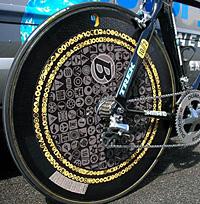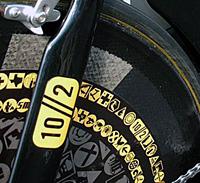
Recently on Cyclingnews.com |
An interview with Lenny Futura, July 18, 2005
The (Lenny) Futura is now
Lenny Futura is probably the first graffiti artist to decorate the bike of a Tour de France yellow jersey wearer, with his iconography for Lance Armstrong's bike. Futura is also responsible for the designs of Nike's new Lance Armstrong 10//2 clothing line, which commemorates the date when Armstrong was diagnosed with cancer.
Now a highly regarded artist, Futura started drawing graffiti in New York, dabbled in rap music and famously worked with the Clash. Futura told Tim Maloney about the journey from Brooklyn to the Tour de France.

|
Cyclingnews: Tell us how you went from Joe Strummer to Lance Armstrong?
Lenny Futura: I'm in the Radio Clash video, which was filmed in New York City in 1981. I was roller skating in the backround, spray painting lyrics from the Sandinista album and stealing spray paint.
CN: Was that shot at the famous Clash shows at Bonds?
LF: Yeah! You're right! You know your shit. So what happened was I first met them when the promoters called me and said 'we have this group called the Clash coming in (to Bonds) and would you be interested in doing a banner that we can unveil for them.' I wasn't really into British music - of course, Beatles, Stones [but] the punk period kinda passed me over. I think coming from America and being an older guy, I was into older R&B, I had more American roots in music. I didn't know anything about the Clash. Even about the Sex Pistols - honestly. So when I first met them and got an opportunity to do something for them, it was more of like a discovery for me. So I got into them and got invited to go on tour with [The Clash].
CN: Where did you go on tour with The Clash?
LF: I went to England. After the Bonds [concerts] - what happened was the Clash sold out the Bonds, they overbooked and had to play like seven nights, so I did that with them.
So when we went on tour, I was doing backdrop painting for them; we went to London and Paris and Vienna, Austria and Scotland and eventually came back to New York. The Clash put me on the map, with visibility and recognition other than what I already had in New York as a kind of underground graffiti writer.

|
CN: And I understand you were also a bike messenger?
LF: This is true; in the late 1980's, at the end of the New York City art wave, when it crashed and some of us burned. Worked for Sprint, worked for Elite and I was probably the only messenger at that time who was into cycling other than to make a living. My wife is French and I've always had a connection to the sport of cycling. I thought I had the physical make-up for the sport and even did well when I was a quasi wannabe. I made a great living as a messenger; I rode a Cinelli fixed bike, and a Simoncini, a Gios. I went through a few frames, I crashed a few. I bought a Pinarello. I wanted a Colnago that I could never afford. I was in Paris when Greg LeMond won the Tour in 1986 and I have a book, 'Futura', that has a photograph of Greg in Yellow that I took from a tree on the Champs-Elysees. And I just got a nice photo of Bernard Hinault. So I remember that period with Hampsten coming on Greg's team as a neophyte. Just the American presence back then was real minimal. Who knew about (cycling) in America then other than your real, you know, die hards?
CN: Did you race in Central Park?
LF: Yeah, I did the club races when I was in the C.R.C.A., but the thing was as messengers, we had our own subculture. We didn't want to be organized, we didn't want a jersey; we wanted to be flashy, independent. I had an accident and that's why I got out of [messengering]. Then my luck turned and I had some artistic opportunities, but I've always had a passion for it. I've done rides here in France - for me it's a big deal. I do my 1600 kilometers in two or three weeks and I'm good to go.
CN: So fast-forward to 2004, when you began working with Nike on the 10//2 project. How did that come about?

|
LF: I've already been working with Nike for a few years, I've done some sneakers for them and a few other spill-off projects. Mark Parker [Nike President] invited me to the 2003 Tour de France [but] I had other obligations, but last year, Mark said "the offer still stands" and I came here and had the chance to follow the Tour for a week. It was the biggest rush of my life. If you love cycling, to get the VIP treatment was great.
I got access to the riders and had a couple of helicopter rides. Went up l'Alpe d'Huez in the Fassa Bortolo car. It was just awesome. So somehow between Lance, Sheryl [Crow], Robin Williams, Mark, the Nike thing... all these degrees of separation. Some of the people around Mr. Armstrong know who I am, like the day I met Robin [Williams] at the Tour, he was wearing one of my t-shirts! And he's a guy that shops at a store in San Francisco I own called Recon, so he's a fan and a supporter of our culture.
Somehow Lance's crew got interested in me and so in late August, Mark [Parker] called me and asked if I would be interested in doing something creative with [Lance Armstrong's] bike next year. I completely lost it and said 'don't play with me like that', but he said it was for real. So it's not only great exposure, but also a chance to get close to an event like the Tour and a human being like Lance, who I think transcends his sport. I think what makes him a phenomenal individual and compels him to an American audience probably isn't the cycling, [and] winning championships. We don't quite know what [cycling] means; we think we do but we do understand that Lance is a cancer survivor; coming from behind, the underdog aspect of it, defying death and the coming back and then winning something as difficult as the Tour de France so many times in a row. I don't have words for how I really feel, it's very emotional."
CN: Talking about your actual designs for Nike's 10//2...
LF: The icons?
CN: You designed an interesting motif that looks like an L, but also looks like a 7, that's on the fork blade of Lance's Trek TTX time trial bike.
LF: That's the gothic L which to me is the L. [The] cowboy boot is the inverted 7.
There was something interesting about the fork and how one letter could fit in there.
The genesis of what we see now came from a very generic motif pattern, not trying to represent anything and just trying to be free and abstract. But Lance and the team from Nike were thinking that we should be more specific to [Lance's] story, so now what we have among those icons are pictograms, almost a timeline of Lance's life. The trailer park, the bridge in Austin where the bats are, his surgery, his recovery, his wins, his crashes. All of what has made him who he is, is quasi-represented in these icons, these motifs. We all collaborated; Lance and some high end people at Nike.
CN: Do you have any art openings or exhibitions happening these days?
LF: I had an opening in London a few nights ago. It's a space called DPMHI; kind of an art space and retail shop, that sells toys and I also do toys. I'm not, quote unquote a fine artist you might have in a classic gallery. I did that twenty years ago and I know that's not my calling. I like a more alternative space to show my work. I don't want to be taken as... I'm not trying to have my work in museums; I'm not looking for that sort of attention, I'm still trying to keep touch with my relative community.
CN: And who is that community?
LF: I would call that individuals of street culture, lifestyle, atmosphere who embrace a youthful consumer society on a global level, whether it's Tokyo, London, Paris, Rome, New York. There's a new movement out there where kids are into toys, sneakers, accessories.
CN: I don't know if you ever got your Colnago, but will you be doing some riding on a bike that has your 10//2 logos on it?
LF: I'm crossing my fingers, that through this thing, one of those bikes may make it's way back to Brooklyn. That would be unreal!
See also: Lenny Futura aka Futura 2000's website
